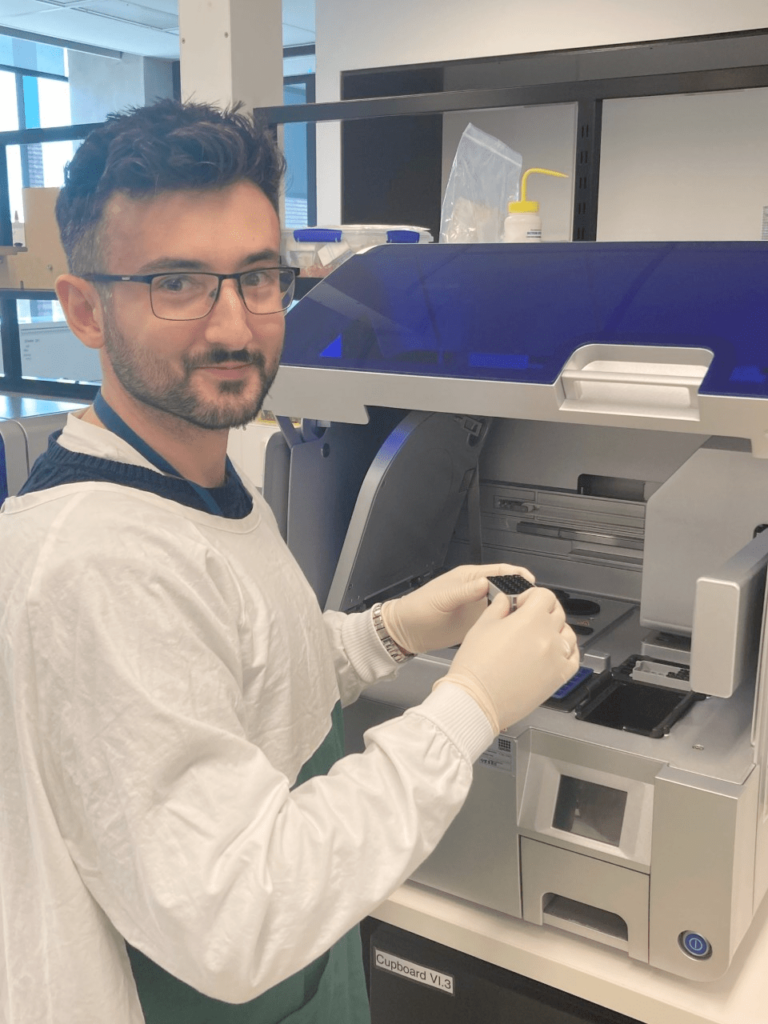By Ken Hickson for Focus on Forests
Love at first microscopic sight. That’s definitely one way of describing how Dr Arif Malik felt about getting his first job.
“I’ve always dreamed of having a job where I could apply all the molecular techniques that I’ve learned to something that could actually make a difference in the world.”
Now a postdoctoral researcher and laboratory manager for the Advanced DNA, Identification and Forensic Facility (ADIFF) in the University of Adelaide’s School of Biological Sciences, Dr Malik describes one of the current projects he’s involved with.
“We will develop genetic markers, similar to DNA fingerprinting, for species of interest including, birch, ash, sandalwood and food items”, he says.
He’s now intimately involved in the project, announced by the University of Adelaide last month (September) – in partnership with Double Helix Tracking Technologies and InterpreData – to develop scientific origin verification tools for global timber supply chains, drawing on a A$500,000 grant from the Australian Government’s Global Innovation Linkages Program.1
Dr Malik explains that it will enhance the development and application of scientific traceability tools for key timber, oil and food products, and to use this information – combined with that from public databases – to develop an online portal for supply chain verification and certification checks.
The DNA identification testing for timber species is crucial, he says, to gauge whether claims of species and origin of wood are genuine or not. It’s often found that organisations that are engaged in illegal logging will have falsified documentation to support bogus claims.
This is where the testing comes in and why it works so well: “Documents can lie, but DNA doesn’t lie,” he says, pointing to a higher rate of validation and peace of mind on behalf of the consumer, too.
“That’s why these tests are important. Not only can this kind of DNA identification testing be used to punish those doing the wrong thing, but it also ensures consumers that they can have confidence that what they’re purchasing is genuine and sustainably sourced.”
Dr Malik is well aware that illegal logging is a major contributor to global deforestation, which in turn impacts the climate crisis. Wildlife and forestry crime is the fourth largest illegal trade in the world.
While government legislation can assist in preventing the importation of illegally logged wood, one of the biggest challenges lies in identifying the species and source of origin of timber.
That’s where Dr Malik comes in. He’s pleased to be a key member of a global team – often working with people in Africa, Asia and the Americas – behind the prevention of illegal timber logging.
By applying genetic techniques to help eliminate illegally logged timber in international supply chains, Dr Malik’s role at ADIFF involves DNA testing, verifying the timber source and contributing to the screening on a global level for timber supply chains.
In the process, this screening is used to identify and eliminate illegally logged timber, acting as a watchdog for an enormous industry.
So we must ask why – and how – did Dr Malik get involved in this intensive research work?
“At the end of my PhD (2019), I decided I wasn’t quite punishing myself enough, and applied for an internship with the Defence Science and Technology group. I got it, and it involved me doing some soil metagenomic work for forensic purposes.”
He was placed at ADIFF and “as they had all these fantastic toys and beautiful labs…I instantly fell in love with it!”
This in turn led to him meeting and getting a job offer from Professor Andrew Lowe, who has a global reputation for being the first to apply DNA fingerprinting techniques to timber tracking work. Besides being the University of Adelaide’s Director of Food Innovation and Chair of Plant Conservation Biology, he also acts as Chief Scientific Officer for DoubleHelix.
As Prof Lowe points out in reference to the current Australian research project: “The tools we employ will be combined into an online portal that has the potential for commercialisation of a screening service to prove timber species and provenance origin.
“If we can commercialise the process and make it more accessible, we could reduce the risk of importation of timber from illegal sources by providing consumers with verifiable confirmation of where timber products came from,” is Prof Lowe’s hope.

Photo credit: Dr Arif Malik
It’s worth reminding ourselves that the University of Adelaide’s ADIFF facility is one of only two laboratories globally that has this capability.
The DNA genetic markers being developed for this project – as they have been for many other projects – will be used in combination with a system to retrieve geographical data from repositories, such as the Global Timber Tracking Network.
Along with an online interface, incorporating supply chain mapping, the project involves documenting the origin of materials used commercially across different companies, suppliers and individuals, within a supply chain.
Dr Malik says a system of barcoding is also being developed for local species. This will help differentiate between timber species and provide independently verified evidence to support product claims of origin, species and legality for shipments of timber.
All this becomes a means to monitor and protect global supply chains from becoming laundering routes, as well as reduce the likelihood of illegal activity being planned.
In addition to screening timber imports coming into Australia, Dr Malik has been working with a range of national and international partners, however the application of these techniques are most closely developed in conjunction with DoubleHelix in Singapore.
He recalls the historic case in the United States, where DNA fingerprinting by DoubleHelix and the University of Adelaide, were used for the first time to get forest crime convictions. Bigleaf maple logs were identified with DNA matched with the timber taken from the stumps in the forest. The result, upon presenting the evidence, was a guilty plea.2
Dr Malik further explains that this screening can assist in not only catching people doing the wrong thing, but it can also act as a deterrent: if people know that this testing is being increasingly used, then they also know that their chances of being caught are also increasing.
Recent work undertaken by ADIFF in an Australian first national DNA testing programme, was able to verify the species and origin of imported timber sold at retail outlets. Its first round of results showed that while more than 60% of the species’ labels were accurate, it confirmed close to 40% of timber imported into Australia was incorrectly labelled and therefore considered to be illegally harvested.3
He’s convinced that all this testing is not just creating a deterrent for illegal loggers; work by DoubleHelix has resulted in the launch of a science-based timber verification system – Nature’s Barcode – which uses DNA and other tests to let consumers know that what they’re purchasing is being legally and sustainably sourced.
Dr Malik believes this could lead to a shift in the way people think: big companies will feel more responsible and take steps to manage risks involved within the international timber trade.
He agrees it might take some time before consumers can know for sure whether the wood in the furniture they buy, for example, has been responsibly sourced and from sustainable supply chains, but the work of the DoubleHelix and the University of Adelaide is heading in that direction.
Two other major projects, which Dr Malik is involved in, also demonstrate the extent to which his team goes to using DNA techniques to verify timber species and sources.
Recently, Dr Malik was involved in putting teak from Myanmar through the intensive DNA testing process to satisfy the stringent requirements of importers in Europe, specifically Sweden in this case.
He worked on three samples of teak stumps and three samples from tree logs, along with three samples of processed timber, and he was able to verify that they were all from the same legitimate forest source in Myanmar.
This use of DNA fingerprinting – matching of timber back to specific trees – helped validate the paper-based chain of custody documentation, along with DoubleHelix undertaking onsite assessments and the use of local Myanmar employees who can speak Burmese.
After scrutiny of the facts and evidence, the Swedish courts in September ruled that it is possible to mitigate the risk of illegal timber from Myanmar through “appropriate and proportionate” risk reduction procedures.4
Darren Thomas, CEO of Double Helix confirms that this decision effectively overrules the European Commission Expert Group position that attempts to justify a complete import ban on Myanmar timber. Instead, it shows that responsible companies can trade in Myanmar teak, so long as they are aware of the substantial risks and take the necessary steps to address them.
Another current international project, which calls on Dr Malik’s laboratory support, involves the African Cherry – officially known as Prunus Africana – as its bark has medicinal properties and is a valuable extract used by European pharmaceutical companies in the treatment of prostate disorders.
The University of Adelaide and DoubleHelix are managing the project, which is funded by the International Tropical Timber Organisation (ITTO), while working under the supervision of Cameroon’s Ministry of Forestry and the Faculty of Sciences of the University of Douala.
On the ground in Cameroon is Germain Yene, the Regional Coordinator for DoubleHelix, who is collecting bark samples and checking they are of sufficient quality, before they are sent to the University of Adelaide.
That’s when Dr Malik takes on the task of developing new genetic markers for the bark and analysing all the samples.5
Steve Johnson of ITTO has noted that reliable tracking of products from CITES-listed species, such as the African cherry tree, is essential for assuring the global community – importers and other stakeholders – that trade is sustainable and not detrimental to the long-term survival of the species.
Dr Malik’s work continues in the tradition of DNA traceability systems, which were first introduced by DoubleHelix in the Indonesian forestry sector in 2007, when they were designed to verify Chain-of-Custody documentation of Merbau wood, processed for export to Australia, New Zealand and Europe. Work that was also supported by ITTO.
If DNA doesn’t lie, nor does this DNA research scientist. Dr Arif Malik says he loves his work and he means it. For good.


